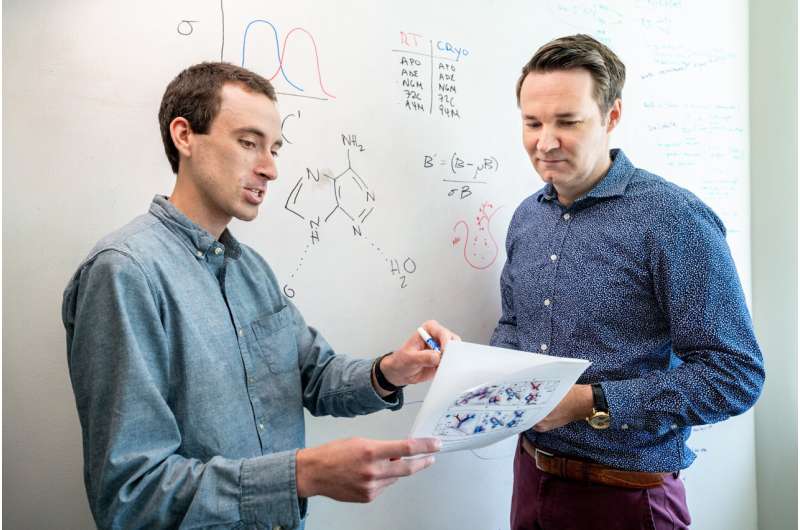Unfreezing waters in ligand binding sites to aid in drug discovery

Cryogenic (frozen) protein structures are central to understanding function and developing drugs. Scientists at St. Jude Children's Research Hospital have created an algorithm to reveal when freezing the proteins may create "artifacts,"—errors that cause misleading results. The research appeared recently in Angewandte Chemie International Edition and highlighted the importance of water networks in protein-ligand interactions. The findings challenge the common view of assuming that well-resolved cryogenic water positions are both precise and accurate.
Ligands are molecules that bind to a receptor protein. When a ligand binds to a protein, the conformation (shape) can change, initiating different types of activity in the cell. Protein-ligand binding and the resulting shape changes are crucial elements to consider during drug development efforts.
"If you only look at the cryogenic data, the information being used for drug discovery has artifacts baked in that you wouldn't know were there," said corresponding author Marcus Fischer, Ph.D., St. Jude Departments of Chemical Biology and Therapeutics and Structural Biology. "We've developed a way to disentangle those artifacts. Using paired comparisons between cryogenic and room temperatures you can pinpoint parts of the protein that are affected by temperature."
Researchers often use available protein structures by pulling the information from a database called the Research Collaboratory for Structural Bioinformatics Protein Data Bank. Around 95% of those structures are captured cryogenically, then modeled within the database for ease of use. Drug discoverers rarely look closely at the raw experimental data, which is in the form of an electron density map. Interrogating maps rather than structural models provides an unbiased approach to revealing dynamic features and cryogenic artifacts.
Flipper algorithm highlights important changes
Fischer and his team developed an algorithm, called Flipper, that looks at the raw experimental data in electron density maps. Flipper identifies map peaks (signals) that would otherwise be invisible. These peaks correspond with the parts of proteins from specific residues that have temperature-sensitive conformations. These residues can change the relative preference for one state over another, or "flip" in their density, moving between conformations, which is where the algorithm got its name.
The researchers used this approach to identify residues that respond to temperature changes and to track the residues in a barcode-like system across the entire protein. This enabled scientists to see how residues inside and outside the ligand binding site respond to freezing or warming temperatures.
"With Flipper we can detect small but important changes in protein structures from temperature or other factors," said first author Timothy Stachowski, Ph.D., St. Jude Chemical Biology and Therapeutics. "It is important to get these details correct early on in the drug discovery process; otherwise, research efforts might be led astray."
Because the temperature and water-network effects influence a vast number of structures, the findings may have a widespread impact on drug development.
A new appreciation for water networks
Armed with their new approach, the researchers conducted a systematic analysis showing the importance of water networks. Water, one of the most crucial and abundant molecules on Earth, plays an active role in the process of freezing conformations. This is particularly true at protein-ligand binding sites.
"This is the first time that we have systematically shown the importance of temperature on water networks for modulating the ligand binding interface, which is where biology happens," Fischer said. "Water is often ignored in the drug-discovery process, but we've shown that in addition to having a profound effect on ligand binding, water also influences binding site residues, capturing them in positions that differ depending on the temperature."
Flipper and the conformational barcode system that facilitates comparisons of different ligands at different temperatures is freely available to enable other researchers to identify such patterns in their own datasets.
More information: Timothy R Stachowski et al, Water Networks Repopulate Protein‐Ligand Interfaces With Temperature, Angewandte Chemie International Edition (2022). DOI: 10.1002/anie.202112919
Journal information: Angewandte Chemie International Edition
Provided by St. Jude Children's Research Hospital




















